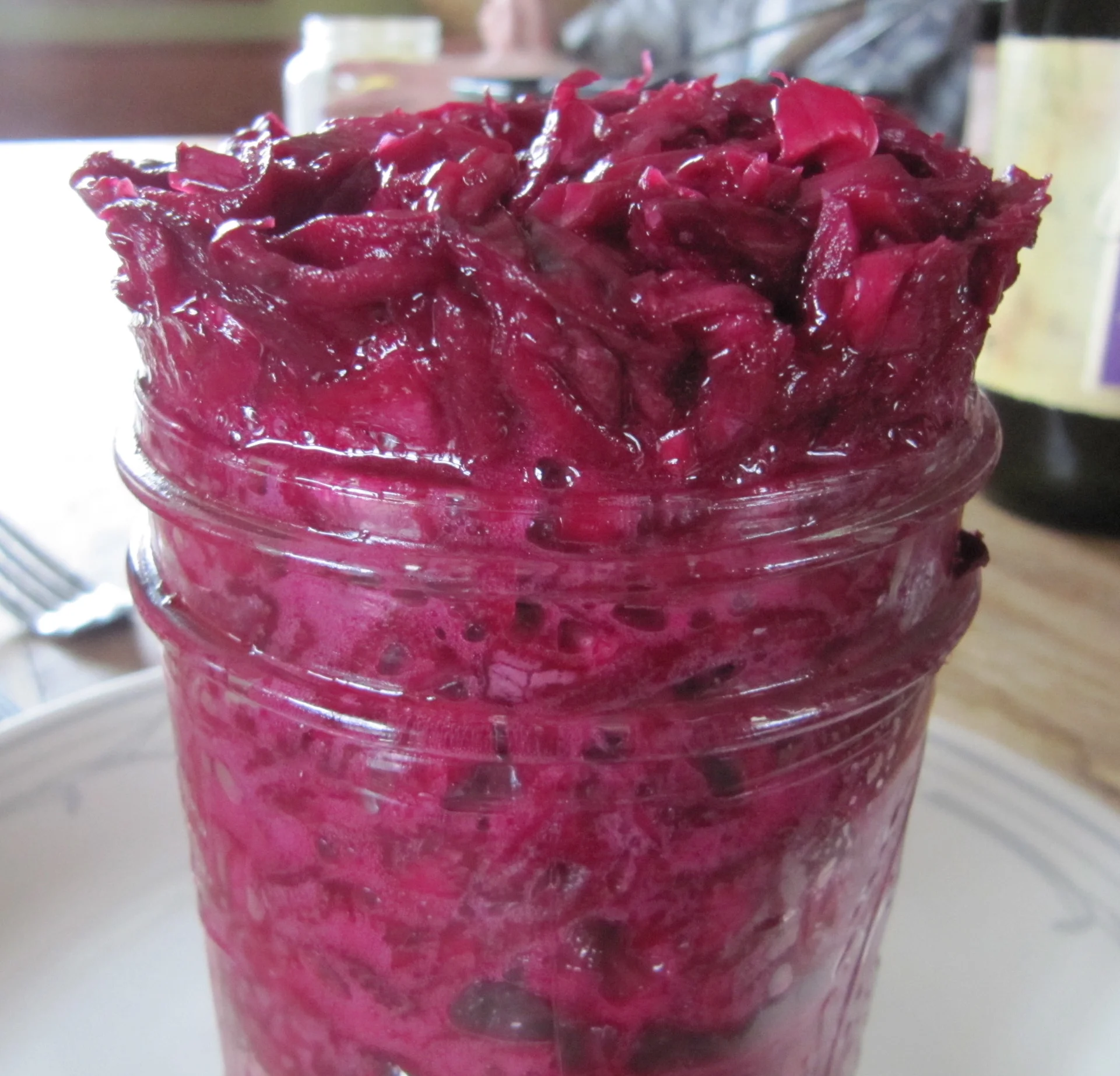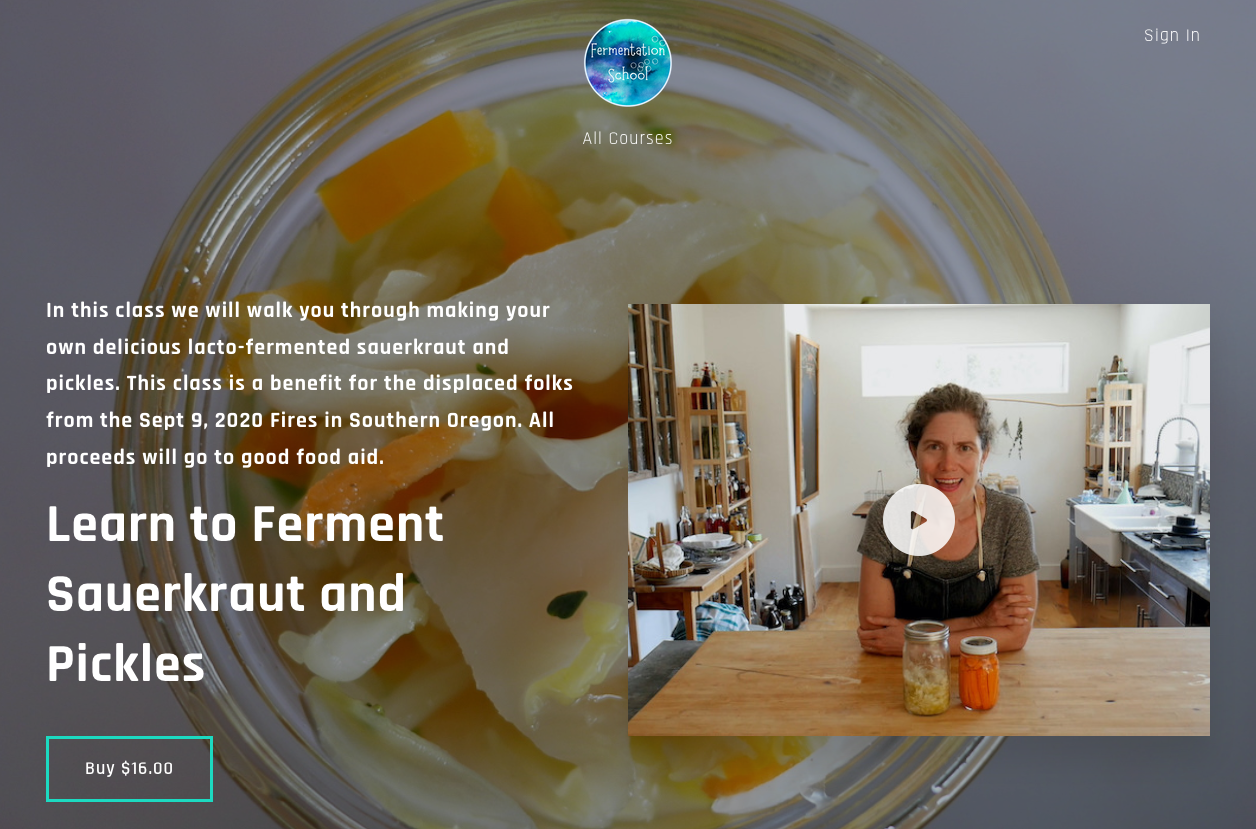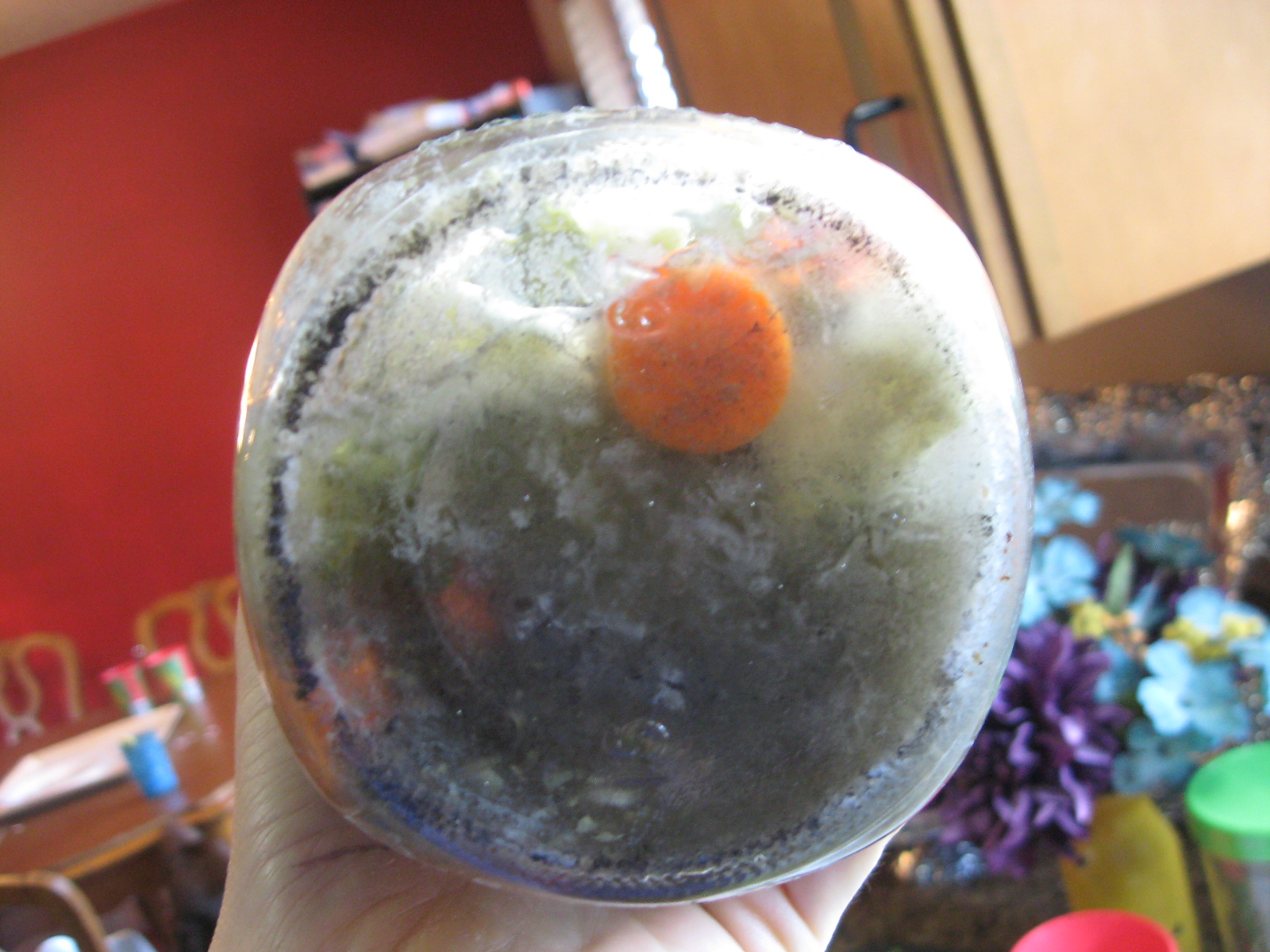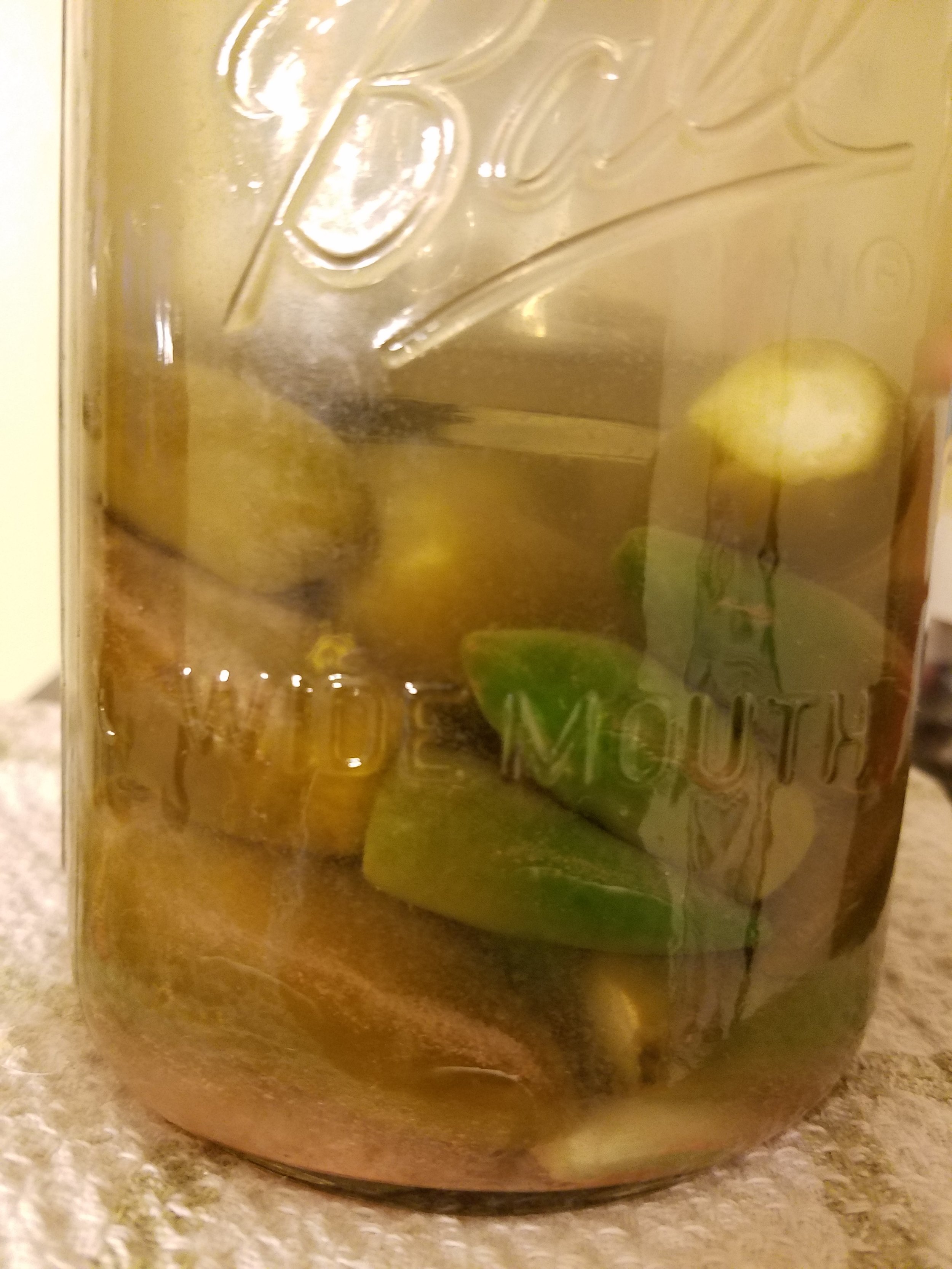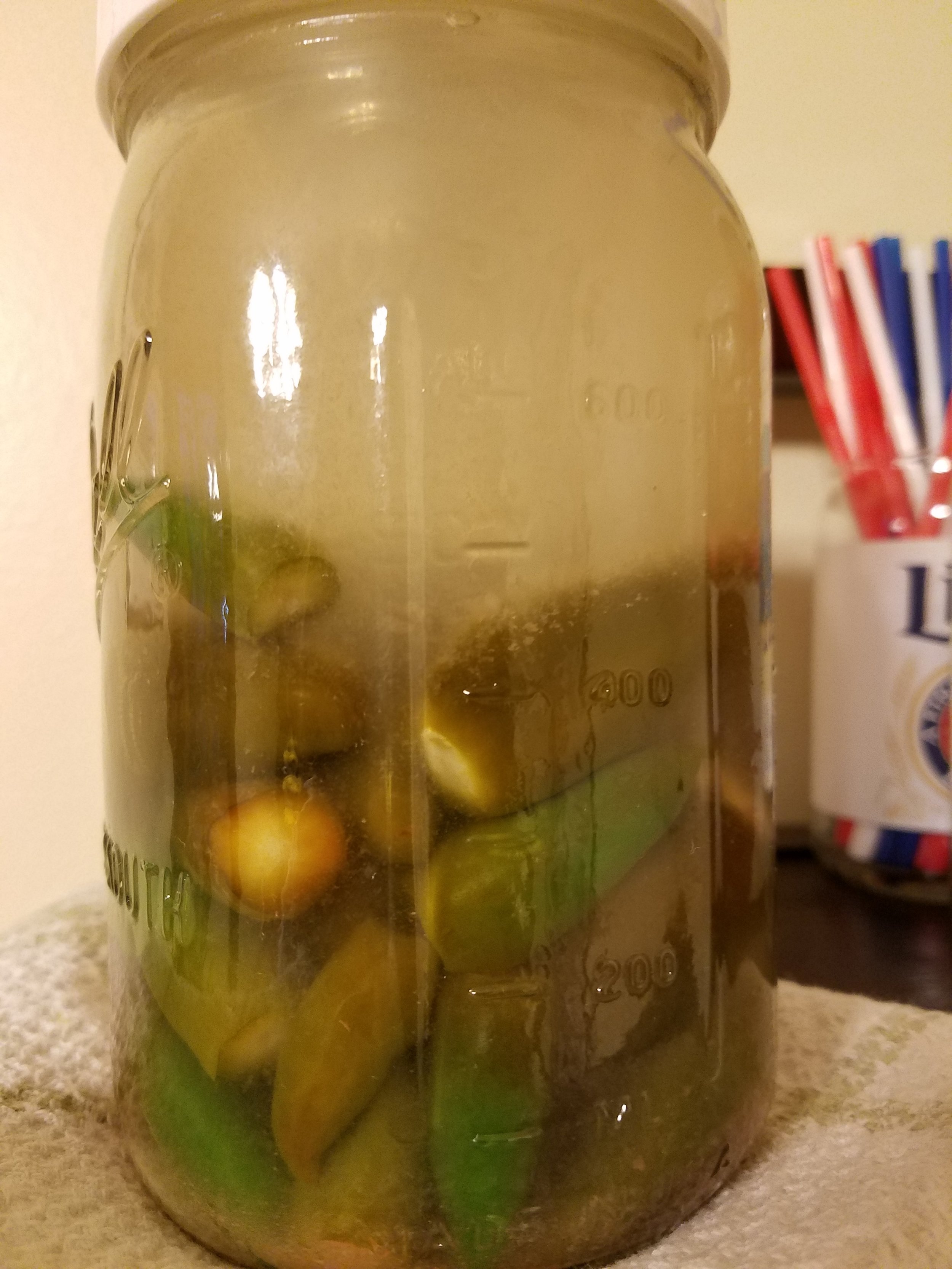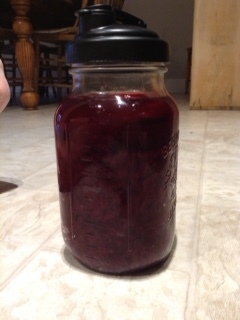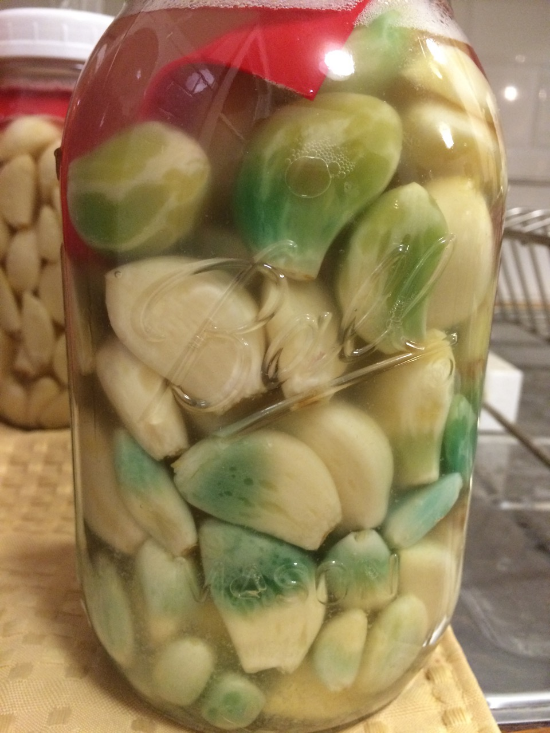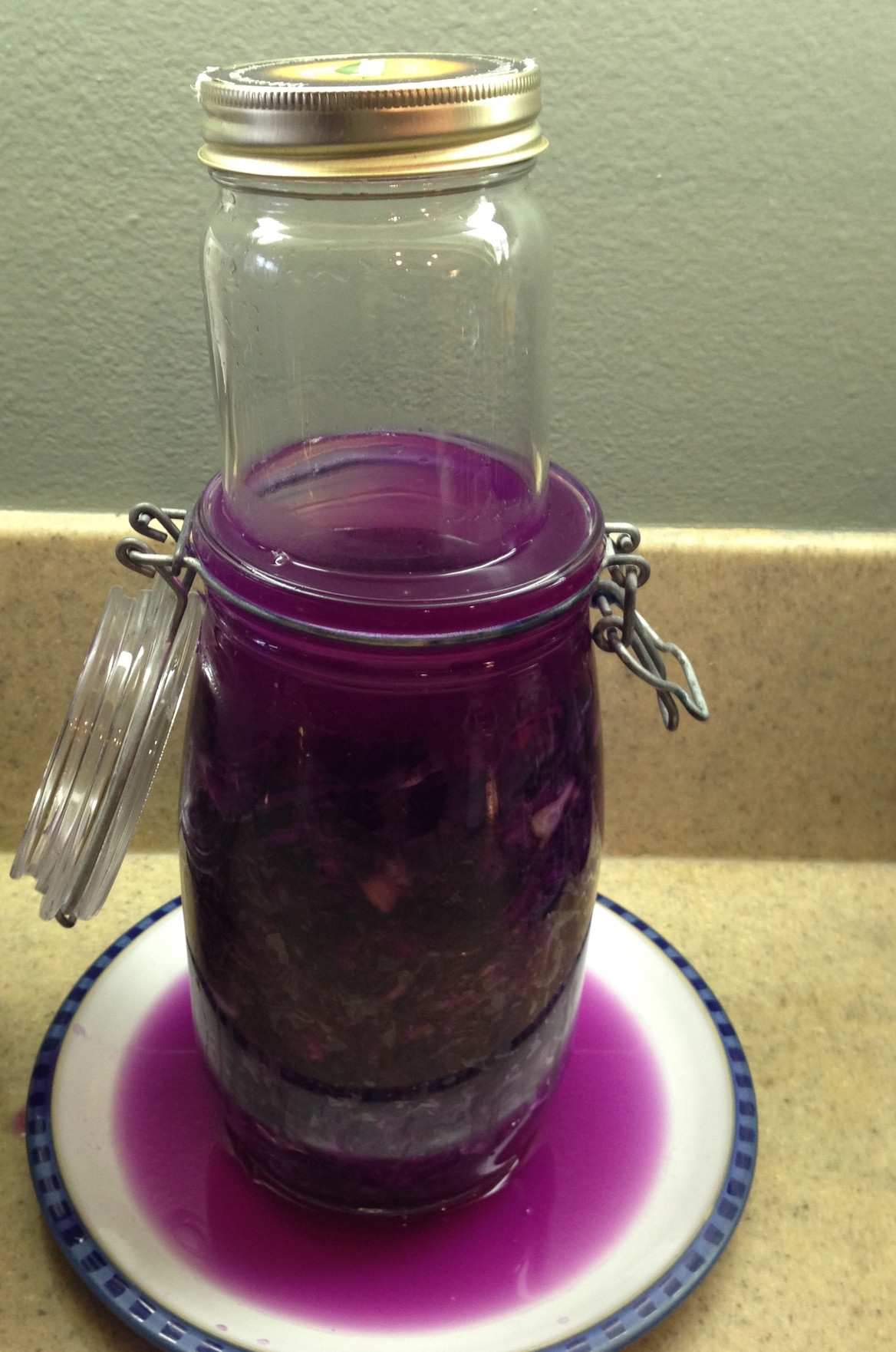Good evening,
I came across your page while worrying about my first ever batch of lacto fermented hot sauce. I've never fermented anything before, so i'd rather be on the safe than sorry side of foodborne illness. When starting, the ferment had tiny bubbles during the first week. The directions I followed stated to massage the peppers after a week, so I opened it up to do so. Other than that, I haven't touched it in 5 weeks. That 1 week mark was also the time, however, that it stopped producing bubbles. Do you mind just letting me know if it looks okay? No bad smell, just a lot of sediment/debris and no bubbles. These are red and green jalapenos along with onions and then spices.
Thank youCasey
**************
Hello Casey,
Thanks for contacting us and sending photos. We have never heard of the massage at the 1 week technique and can’t think of why that would be suggested. Maybe the author had an issue with whole peppers not getting the brine inside them so they thought they should me massaged? Don’t know but I would suggest leaving that off your next batch process, you really should not need nor want to handle the ferments while they are fermenting. Opening the lid also releases the protective CO2 layer that should be captured under the lid and water in your air lock. Is there water in your air lock on top of the lid?
On to good news - they look fine. That sediment you see is normal. I would suggest spooning some out and tasting. If you like then you might think about spooning all the vegetables into your blender and adding ¼ of the brine you think you will use and blend. Check the consistency and keep adding brine until you get to the sauciness you are imagining.
Let us know how it goes Casey.Cheers
Christopher
Pink floating bits on top of brine
Onions garlic dill bay leaf and asparagus getting bubbles and red pink floating bits looks like mold
See pic attached thanks
****************
Hi there,
That does look like some kind of unwelcome pink microbial growth. The good news is that you have a great deal of brine and your veggies are anaerobic and safe under the weights.
Skim off the top layer catching all of these bits.
I wouldn’t get into the ferment until it smells good and pickle-y. When it is time make sure that none of this has grown back. If it has skim it off again.
Once you get into your ferment if it smells and looks good it then it is. If it smells off then it is likely off and you will want to send it to the compost.
I hope that helps,
Kirsten
Fermenting asparagus is wonderful. In this post, we walk through a simple pickled asparagus recipe. In this post, it looks like an even bigger amount of asparagus was being fermented.
Pickling vegetables like asparagus and onions is really pretty easy, as you saw from the video above. If you feel that you need more help making your first batch you can pick up a copy of our Fermented Vegetables and we will be happy to sign a copy to you or your friend and ship it out tomorrow. If you would rather see it, really see it, how about a personal online class? Here are a couple of good choices.
Gelantinous, thick, milky, fermented garlic brine
Strangely enough both of these letters came within a day of each other sharing the same question regarding a thick fermented garlic brine.
While they look all wrong both these ferments are fine. It happens sometimes with garlic. We don't know the reason behind it but these ferments. It is not mold and we haven't found that it happens from a process error. More likely it has something to do with the variety of garlic. I have done a lot of variety testing and found some varieties do this while others do not. While this brine unsightly, are perfectly safe and taste good as well.
Hello!
What a helpful resource your site as been! Thank you for offering to give us individualized advice.
I’ve had a garlic ferment in my cabinet for about 2 weeks. I’ve checked it every other day. The garlic is completely submerged below 3 clean rocks. I’ve checked the ferment every other day, letting out the air. Today when I checked I noticed this milky white stuff floating at the top ¼ of the jar, more around the rocks, less the garlic. I’m attaching 3 pictures and my attempts to draw lines to what your eyes should focus on.
Is this the start of mold growing? Or is it something else? The ferment has appeared healthy to date, a lot of bubbling every day, and a few cloves have started to turn blue.
Thank you,
Sherry
Hi Kirsten,
I started a batch of fermented garlic and it just hit the 4 week mark. It had been doing great and was bubbling lots, but a few days ago (maybe a week) I noticed that the bubbling had mostly stopped and the brine turned kind of gelatinous. You can see small solid chunks throughout the brine. The smell and color still seem fine, there’s no mold, and I think it’s ok, but am unsure since this is my first long-term brine. Is this safe to eat?
**********************
We've consolidated the answers to both of these into the text above.
Dark grey sediment in my ferments?
Good morning Ms. Kirsten,
I found your site through a Google search and can't thank you enough for providing the help section! This is our first attempt at fermented vegetables. They have been bubbling, the lids swelled a little and became hard, and they have been seeping (all of which I'm guessing is normal). What wasn't mentioned in the recipe is that the brine developed these grey, sediment-like particles that began floating throughout each jar but mostly settled to the bottoms (looks darker in person than in picture). Each of the 9 jars also developed a dark grey/black ring around the bottom. Is this a normal/safe ferment? When I opened one this morning (day 8) it was hard to open and fizzed, bubbled and sizzled as if it's been fermenting fine and there does not appear to be any discoloration on the cabbage leaves I used to hold the veggies under water. Thank you so much in advance for your time!
Kind regards, Elizabeth
************************
Dear Elizabeth,
We are glad to hear that our site is helpful. You are right all that “action” is quite normal. The sediment is also quite normal—in fact when I see cloudy brine and sediment I know that the process is working well. The black bits of sediment are not normal in and of themselves but I am guessing that they are from a grey Celtic style salt or that they are a spice or herb that your recipe may have called for that has also settled along with the sediment. If you don’t feel that is the case, let me know what was in the recipe and we can look a bit further into it.
As far as the cabbage leaf on top of your 8 day ferment it looks normal to me. I don’t see anything in the photo that concerns me, it does as well as the other photos, look like they are not fully fermented yet. In cooler temperatures 8 days can still be a young ferment — in hot temperatures 8 days can be over fermented. So it depends. If it is ready it should be smelling nice and acidic —pickle-y :) If it does then go ahead and reach under that leaf and taste it. If it is tasty you can put it in the fridge if it isn’t sour enough then close everything up and let it go a few more days.
Remember if a ferment is bad it will let you know—the smell alone will say don’t put me in your mouth.
I hope this helps.
Kirsten
Pinkish Sediment on Fermenting Peppers and Irregular Color
Hi Kirsten,
I'm new to fermenting, and as my second foray into it, I have a bunch of jars of various whole peppers fermenting, including the pictured jar of jalapenos and serrano peppers. The rest of the jars seem to be doing well, no cloudiness, no mold, etc, but the jalapeno jar's brine is cloudy, and there seems to be a fine, almost powdery looking, pinkish white sediment on the peppers as well as the bottom of the jar. I also skimmed a little mold off the top of the brine at one point - just a few little pinhead-sized floaties. It still smells alright, peppery and pickle-y and salty. Just wondering if this should be composted or if I should continue the ferment? It's been 2.5 weeks since I started it. Oh, and I used Himalayan pink sea salt to create the brine - could this be what the pinkish color is from?
Any advice you could offer would be wonderful! I can also try and take more or different photos if needed as well.
Stefanie M
*********************************
Hi Stefanie,
Welcome to the world of fermentation! Your ferments look fine. The cloudiness and sediment is a normal part of fermentation. In fact, when I see it along with the color change of the veggie I know things are progressing nicely. You did the right think to skim off the mold and that has nothing to do with the sediment you are seeing. You are probably right that the pink color has to do with the salt. We use Redmond Real salt, which also creates pink sediment.
If it smells pickley that is a good sign also. If it was head for the compost it would smell awful.
The thing that I wonder about is that some of the peppers are still quite green. Did you add a few more peppers after a couple of days in? I am guessing if not they are just slower. The ferment looks done except for those peppers. When then turn dull green it likely will be.
Cheers,
Kirsten
*****************************
Hi Kirsten,
Thank you so much for the information! Glad to hear all is normal with the ferment. All of the peppers were added at the same time, but the Serranos are still bright green as opposed to the jalapenos. Should I remove the finished jalapenos for tasting, or should I wait until the serranos are also finished?
Additionally, the other peppers I have fermenting are yellow, red, or other colors (super hot peppers - peach scorpions, chocolate reapers, etc.). Is there a definite color change that will occur with these as well? They are still quite vibrant.
*****************************
You are very welcome.
No need to remove any peppers. The Serranos are just taking their time, and I do see that they are changing. I was just curious as it is a little unusual to see some that are so different in the same jar. And no you won’t see any color change in the reds and yellows, the chocolate reapers are brown right, those might change a bit. It has to do with the colors being water or oil soluble pigments. Carrots, red peppers, etc. are oil soluble and will not change or “fall out” into the brine. Water soluble colors (the pink in a radish) may color the brine and the veggie will turn dull.
Hope that helps.
Cloudy brine and sediment in my carrot sticks
Hello Kirsten and Christopher,
I recently purchased your book and attempted to make the sauerkraut and fermented carrot sticks. I'm a bit concerned about my carrot sticks. They have a thick cloud and white sediment at the bottom, which I read is normal, but they taste a bit vinegary and are softer than I imagined. They are about 6 days in. Do they look okay and how acidic should they taste?
Thanks,
Ryan
***********************************
Hi Ryan,
Thanks for getting and using our book. It looks like you have a bit of kahm yeast, that is the white stuff on top. It is harmless but likely is the cause of the softer texture. Fermented carrots are not super acidic so it sounds like they taste fine. They look fine from the photos, apart from the yeast. Again this is harmless and it happens sometimes, I would scoop it off as much as you can and then refrigerate. It should go away or at least slow down to a point that it won’t bother you.
All best,
Kirsten
Fermented Garlic Brine is Blue-Green
Hi Kirsten,
Thank you so much for your kind invitation to send in fermenting issues.
I am an eager newbie to the world of fermenting. Garlic has been my first foray into this world. Please see attached an image of my attempt.
I'm concerned about the colour the brine has turned. It is decidedly green and there is a strong garlic smell emanating from the closed jar. Is this to be expected? I understood the cloves themselves may turn green or blue during the process but not the liquid?
I'd be grateful to know what has happened and what I can do to get a good jar of ferment. Thank you in advance for your assistance.
Kind Regards,
Carol
**************************
Hi Carol,
Ah yes, the blue-green hue. You are right it is a little different seeing it in the brine. My guess is that the brine is thick with the garlic sugars. The whole cloves we make can have a very thick brine and that the blue-green is actually on the garlic that is now in the brine. Sometimes when they sit in the fridge for awhile the blue will work itself through.
This ferment looks okay to me but you be the judge (and trust your gut). If it smells strong like garlic, that is normal, if it smells strong like bad, compost, or whatever, then I would say it is bad. It should also smell a bit pickle-y.
It doesn’t always happen so don’t be discouraged and again I think they are fine, when you are ready to taste them, you will know. Pickle-y acidic garlicky is good, any thing else is not.
Cheers,
Kirsten
Thick Sticky Beet Brine
Hello Kirsten.
The brine on my beets is very thick and slimy.
They did not bubble very much for the three days I had them fermenting.
I wonder if I packed them too much?
And if they are safe to eat.
They are crispy and do taste OK but I'm worried. This is my first attempt at fermenting.
My thanks for this help.
Merilyn
__________
Hi Merilyn,
Beet brine is very thick and viscous because beets have so much sugar. The other thing is that 3 days isn’t very long for a ferment like this and sometimes there is a thick slimy phase in fermentation that will work itself out. The picture I am sending is a ferment that is fine but went through this slimy phase. It happens sometimes.
I think you are fine and that they are very safe. The important thing to remember is that if they are bad (as in unsafe) they will be awful smelling and tasting too.
I would let them ferment a little longer and realize beets are also just like that to a point. I hope that helps.
Cheers,
Kirsten
This sauerkraut was fine, it smelled good and had no scum. The problem was the viscous brine. It was quite unappealing. This happened because the ferment had been fermenting very slowly at temperatures in the low 50° F range. We advised the maker of this kraut to move it into a warmer space and ferment it longer and Violá it worked! The kraut was perfect in a few days.
Fermented Garlic Turned Blue
Hi there!
Firstly, I want to say that I love this book! I have been fermenting every vegetable I can get! Force-feeding everyone around me, too. :)
I have a question about garlic. I started the jar a week ago, and it has been bubbling away. For the last day I notice some of the cloves (I put in whole cloves) are turning a strange blue or green color. I'm totally paranoid because of all the press about Chinese garlic! Is turning colors a sign that it's tainted? Is it normal??
Thanks again for writing the amazing book! I'm so happy to have learned something new!
Sarah
***
Hey Sarah,
Anyone force-feeding fermented veggies to the ones they love has our heart. :)
I think every fermentista remembers their first blue garlic. The good news is that our research and experience is that its harmless. If you turn to page 182 in the book you will see the little Fermentista’s Tip on it. The timing of your message is great because Kirsten has a batch of fiery ferments going for the new cookbook and one of them did the blue-green thing on us. We also fermented about 30 lbs of garlic with a farmer friend a week or more ago and all of those are beautiful little creamy orbs like they are supposed to be.
So its okay, it will taste fine and be a conversation starter for sure. Lastly, we have noticed over time in the fridge many times (though not always) this blue fades.
Let us know how all of your creations turn out Sarah and if you have any more questions.
Christopher & Kirsten
Are my fermented pickles ok?
Dear Kirsten and Christopher,
I bought a copy of your book last month and successfully preserved a bunch of farm fresh vegetables using your fermenting techniques. However, I am having some doubts about my pickling cucumber ferment. I followed the NY Deli-style pickle recipe. After 5 days I noticed Kahm yeast and removed it. Before refrigerating I noticed some slime so I added more salt to the brine. Upon doing so, I noticed white clumps formed the minute I added a bit of grey sea salt. The water itself looks cloudy and some of the pickles seem to want to float. The white clumps have since settled to the bottom of the jar. The brine itself smells great but before tossing the batch and deeming them unsafe to eat I thought I would get a second set of eyes to look at my jars of pickles. Please see the attached pictures. Any feedback would be greatly appreciated.
Many thanks,
Tina
Hello Tina,
Thank you for the pictures, they really help. All veggies want to float in the brine and it looks from the pictures like maybe they did some floating in the jar. If any of them did slip out from the pack and float to the top that would be a conduit for develop enzymatic or yeast infections. We are guessing you may have one or both on this batch. Cloudiness is normal but the white chunk is baffling to us. Our recommendation honestly Tina is to compost this batch and try again. If you are up for that really pack them in tight and under that shoulder of the jar - they should be in there tight enough that none can float to the top. It also helps to find a tannin rich leaf—grape, oak, horseradish to tuck over the top to keep things under the brine and crispy. We hope you still have cukes and that you have a good second batch.
Christopher & Kirsten
Brownish Brine
Question: I just started fermenting. First I made sauerkraut - Delicious! Now I just made your asparagus & caulikraut recipes. The caulikraut looks great but the asparagus brine turned brown after 1 day. Is this okay??? Thanks for your help.
Answer: The brine in this picture looks fine. It is at the beginning of the process and often at this stage the brine will take on some of the colors from the vegetables or spices. This is a normal color for asparagus. You will continue to see changes in the color of the asparagus as well as the brine.
If you would like to learn how to make sauerkraut or pickles we have a couple of courses now available at our fermentation school:
Mastering Fermented Vegetables It covers it all. This complete vegetable fermentation course will teach you the skills and give you the confidence to ferment any vegetable safely and effectively.
Learn to Make Fermented Hot Sauces Learn to ferment hot sauce with any pepper you love. You can choose blazing hot or super mild peppers, fresh or dry and blend in other flavors. This fermentation class will teach you everything you need to make your own safe probiotic hot sauces.
Learn to Ferment Sauerkraut and Pickles In this class we will walk you through making your own delicious lacto-fermented sauerkraut and pickles. This class is a benefit for the displaced folks from the Sept 9, 2020 Fires in Southern Oregon. All proceeds will go to good food aid.
Is my brine fine?
Question :: "This brine keeps overflowing! I put the batch in a larger jar and submerged it was another jar of water like you mentioned, but the brine keeps spilling out. How does volume increase like this? Just expanding? Oh wait, I pushed down on it, and it released a ton of bubbles. So I was able to pour that brine back in, and it seems like I'll just keep doing that? Should I put it in divided jars?"
Answer :: You are right that pressing it down and letting the brine sink back into the cabbage is what needs to be done. The jar is quite full and so there isn't much room to accommodate the action. You will need to press it down regularly, or you can press it into a larger jar. Thanks for the photo!
As far as the CO2 action you are seeing--it is different all the time. Some cabbage batches are not as active as well…its a funny thing and hard to predict. The good news is even the quiet ones are working.

